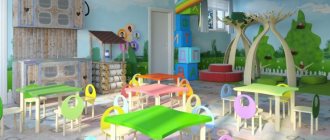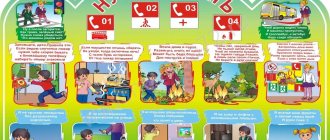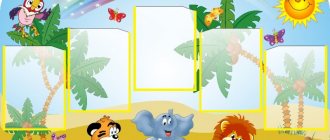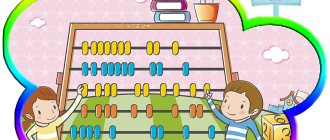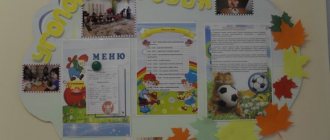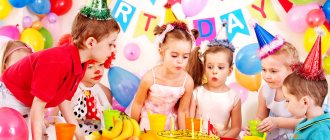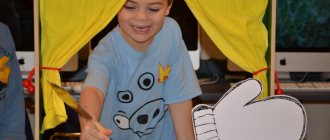Kindergarten is a child’s first social institution. Here he is constantly in the team, regardless of his thoughts, mood and experiences. At the same time, one of the tasks of a modern preschool institution is to ensure the emotional well-being of students. The development environment should facilitate this. In each group room, the teacher arranges a special place where the preschooler can be alone with himself, relax, and throw out negative emotions. Such an area is called a corner of solitude (or, according to the Federal State Educational Standard, a center of solitude and relaxation).
- 2 How to design a retreat center for preschoolers of different ages
2.1 What to make a frame for a corner of privacy from2.1.1 Photo gallery: types of frames for a corner of privacy
- 3.1 Passport of the corner of solitude
- 4.1 Items for expressing negative emotions
4.1.1 Photo gallery: objects for splashing out negative emotions
- 4.2.1 Photo gallery: items for relaxation and relaxation
- 4.3.1 Photo gallery: benefits for enriching the emotional sphere
- 5.1 Photo gallery: working in a corner of solitude
The purpose and objectives of creating a corner of solitude in a preschool educational institution
As the nervous system of a preschooler develops, his mental state is very unstable. It is easy to surprise, amuse, and offend a child. The teacher must be able to regulate the children's emotional sphere. After all, according to psychologists, suppression of emotions can provoke neurosis in its various manifestations. In no case should a child be shamed, much less punished, for showing feelings (anger, fear, wild fun, etc.), since he does not know how to control them due to his age.
Preschoolers should be taught to express negative emotions in constructive ways.
In order to provide children with psychological comfort, special corners of solitude, or relaxation zones, are created in preschool groups. A number of tasks are aimed at achieving this:
- In early preschool age, the main purpose of the retreat center is to facilitate the adaptation process, help children survive separation from their mother and get used to the teacher’s requirements. The corner of privacy is filled with objects for which the child has warm feelings; soft, beautiful pillows and toys will allow the baby to escape and relax.
- Teach your child to express his anger in an acceptable, safe form, and prevent excessive stimulation of the nervous system, which can lead to overwork. So, in the corner there may be special pillows for whipping, a box or glass where anger and resentment are thrown out, etc.
- Help preschoolers learn techniques for regulating their mood and ways to gain self-confidence. For this purpose, a mood board is placed in the corner, where you can draw your emotions or teaching aids, illustrations of various emotional experiences.
- Increase the self-esteem of anxious and shy children.
- Teach children to communicate without conflict with each other, to minimize possible quarrels in the children's team. An island of reconciliation will help with this - a special rug on which children peacefully resolve conflicts.
At a younger age, the teacher at the right time invites the child to go to a corner of solitude (for example, when he notices that he really misses his mother in the morning, feels squeezed, uncomfortable, or, on the contrary, behaves aggressively and offends other children). In the middle and senior levels, the children themselves already show a desire to go to the recreation area (and the teacher, in turn, does everything to ensure that they fall in love with this place). They already know perfectly well what can be done there and how to help themselves find peace or simply cheer up.
A preschooler may independently express a desire to go to a corner of solitude, or he may go there at the prompting of the teacher.
In the corner of solitude there should be objects that cause pleasant experiences in children, for example, balloons
Game “Pass the Mood”
Recently, the game “Pass the Mood” has become very popular. Using pictures of emoticons or specially selected photographs, the child recognizes and distinguishes a person’s emotions, learns to determine his own state of mind and the mood of his comrades.
The game can take place in class or during the morning reception of children in kindergarten. In front of the children, the teacher lays out cards with drawn emotions, a sample is given in the photo above, and the children find the right card.
How to design a retreat center for preschoolers of different ages
When designing a corner of solitude in general, the teacher should focus on the age of the students. Thus, in the junior preschool level, the Mink design will be relevant - a small space with a small entrance that will give the child a feeling of comfort and safety. There, the baby will be able to sit or lie down in the company of plush toys that can be hugged (after all, tactile contact is very important at 3-4 years old) and other objects. Mandatory attributes of a “mink” are a soft rug and pillows.
For younger preschool age, the “Mink” design is relevant - a miniature tent house with a small entrance
For middle and older ages, the “Tent” design is suitable. The house will already be taller and more voluminous. The place of the small round entrance is taken by curtains or a screen. There are much fewer soft toys here (or maybe not at all). The design of such a zone gives the teacher the opportunity to show all his creativity and imagination. The tent can be transformed into a fairy-tale cave, a gnome’s house, a sunny room, an underwater kingdom, etc.
What to make a frame for a privacy corner from
Options for the frames of the privacy center can be different:
- A simple option - one corner of the group room is fenced off using a curtain attached to a cornice, or an ordinary screen. The fabric should be decorated with paper flowers, stars, butterflies, smiley faces, etc.
- You can build a house frame from plastic pipes and cover it with fabric.
- The role of the leading structure can be played by an ordinary large umbrella (the ideal option is a beach umbrella), to which a fabric or curtain made of ribbons is attached: this can look very original. You can also use a large lampshade.
If there is not a lot of space in the group, then you can use a screen to create a privacy zone. This is convenient because such a corner will be mobile: it can be moved from place to place at the request of the children and the teacher.
Using a screen, you can create a cozy place for privacy, complementing it with the necessary attributes
Photo gallery: types of frames for a corner of privacy
A corner separated by a curtain - a very simple and compact design
Plastic pipes covered with fabric create a stable structure
An umbrella with long ribbons sewn onto it is simply attached to the ceiling
A corner of a beach umbrella with ribbons looks like a carousel
If you attach a long translucent fabric to the lampshade, you will get a cozy corner of privacy
Photo gallery: ideas for decorating corners of privacy
In such a house, preschoolers will be able to feel like forest dwellers
Inside such a tent, a child seems to find himself in a magical world.
The screen transforms into a beautiful fairy-tale tower that can be moved from place to place
In such a house, a child will be able to imagine himself as a hero of a Russian folk tale.
Long multi-colored ribbons can serve as curtains
For older preschoolers, you can not completely fence off the area, but make a dome that symbolizes privacy
A luxurious princess tent can be made from ordinary tulle fabric
A beautiful tent is complemented by a soft clearing with a fence
When organizing a corner of privacy, you can use the space between children's furniture
Video: how to design a corner of privacy in kindergarten and at home
Video: Russian-style retreat called “Gorenka”
Structure made from natural materials
You can make a DIY house for a kindergarten from branches of trees or bushes. It is advisable to choose material of the same diameter so that the hut resembles a real log house. The structure is built from the bottom up on the prepared foundation. The most convenient way is to take a lid from a candy box, cover the bottom with sand painted with gouache paints, after having generously spread the surface with PVA glue.
The branches for the house are cut into equal lengths with a sharp knife or wire cutters. A glue gun or universal glue will hold them together. To make branches for the roof, you need to cut them according to a triangle pattern, the edges are pasted over with a whole branch. For the roof you need to make a base from thick cardboard. It can also be assembled from twigs, but a craft made from dry grass or autumn leaves, which are located in bulk along the entire base of the roof, looks more interesting.
Additionally, you will have to work on individual details of the structure, for example, making doors, stairs or decorating windows. A do-it-yourself craft house for a kindergarten looks beautiful with the help of leaves and growing trees scattered in the yard. If you didn’t use a ready-made candy box for the building, then be sure to make a fence for the house. A fence made of weaving from thin rods looks impressive. Our ancestors have long built wattle fences around their houses. When decorating crafts, it will also look great at an exhibition.
Rules for designing a corner of solitude according to the Federal State Educational Standard
The Federal State Educational Standard imposes certain requirements for the design of a corner of solitude in a preschool educational institution:
- It should not be too large in size (after all, it is a miniature house, marquee or tent that gives a child a feeling of comfort and tranquility).
- The color palette of the corner does not imply too bright colors; the lighting should be subdued.
- A soft rug and pillows are required on the floor (as an option - a child's chair), soft modules are welcome.
A fluffy rug, pillows, plush toys will create a feeling of coziness and comfort.
- The object environment in the corner should be of a developmental nature (and not just beautiful and cute little things that are pleasant to touch and look at) and encourage preschoolers to self-improvement and creativity.
- The filling of the relaxation zone should be varied. The teacher periodically changes the attributes for games, but some things are always present: this gives the child a sense of stability.
- When preparing manuals, the teacher must take into account the age characteristics of preschoolers. Toys, attributes and educational materials must also meet aesthetic and hygienic standards.
- We must never forget about safety precautions: sharp and easily breakable objects are not allowed in the corner.
So that the teacher can at any time make sure of the safety and normal well-being of the student, it is advisable to make a “window” in the corner of privacy that will not violate the child’s personal space.
By looking through the window, the teacher can quietly assess the child’s condition.
Passport of the corner of solitude
For each retreat and relaxation center, the teacher must issue a passport. The following points are stated there:
- Name of the zone (for example, “Island of Solitude”, “Cozy House”, “Nest”, “Relaxation Island”, etc.).
- The goals of organizing a corner of solitude and the specific tasks it performs.
- A list of equipment available in the corner and a brief description of how to interact with each teaching aid.
Filling the corner of solitude in kindergarten
The most important component of the recreation area is the objects that fill it. Three main groups can be distinguished here.
Items for expressing negative emotions
Pupils of preschool educational institutions can express negative experiences using a number of objects:
- Whipping pillows, crying pillows (to cry on).
- “A glass of anger” (alternatively, it could be a box, basket, chest, etc.). This is a beautifully designed glass (preferably with a black background) with a lid in which a child can leave his bad words and thoughts. When the baby speaks out, he closes the glass tightly and hides it.
- "Rug of Anger." This is a small rug made of coarse yarn or rough fabric. The preschooler takes off his shoes and wipes his feet until he stops being angry.
- "Island of Reconciliation" This is a small rug, beautifully designed, made by hand. The quarreling children stand up to him and resolve the conflict, making peace. For similar purposes, you can use a tube or mittens: a cardboard tube is interestingly painted or decorated with appliqué, two children each put their hand into the tube from their side, in the second case these are mittens tied with a string.
- Mirror for a good mood. When the teacher notices that the child is not in a good mood, he invites him to sit in the corner in front of the mirror, look at his reflection and smile.
- Mug "Shouter". As you know, when a person screams, negative emotions come out. In order not to create noise or frighten other children, the child is asked to shout into such a mug.
Photo gallery: objects for splashing out negative emotions
Looking at his reflection in a funny mirror, the baby calms down
Along with screaming, you can throw out anger and resentment
A pillow or soft module that can be beaten will help the child release anger and aggression
A child leaves his bad thoughts and feelings in a glass of anger
The purpose of such a little world is to transform children's conflict into an exciting action
Items that perform a calming and relaxation function
To relax preschoolers, the following can be used:
- Sensory toys. In younger preschool age, these are lacing, mosaics, wooden puzzles-insets. At an older age, you can add pictures here that the children form with their own hands: using Velcro, they attach individual elements (flowers, plants, insects) to the general background.
- Beautiful tabletop fountain, waterfall.
- Player with relaxation compositions: the sound of the sea, sounds of the forest, rain. At a younger age, the teacher turns it on; older preschoolers are able to do it independently.
- Musical toys (for example, a box), toys that make sounds (for younger preschoolers these can be ordinary “squeakers”).
- A photo album with group and family photos (it’s interesting to look at the families of all the pupils), photos of pets, an album with images of your favorite fairy tale and cartoon characters.
- A toy phone for imaginary calls to mom and dad.
- Massagers, small hedgehog balls, tactile bags (filled with sand, flour, cereal, salt, etc.).
- Collections of sea shells, magnets.
- A basket with balls of different colors and textures.
- Bottles with shower gel (you can dilute glycerin with water), in which beads and New Year's tinsel float. When the container is turned over, the elements fall down beautifully - watching this calms the nervous system.
- Materials for art activities (primarily for modeling - plasticine, colored dough).
Staying in a corner of solitude allows children to relax, recuperate, and interesting games help develop fine motor skills.
Photo gallery: items for relaxation and relaxation
Squeaker toys help little children calm down
Looking at a photo album helps a child calm down
A tabletop fountain or waterfall will have a fascinating effect on the child and will calm him down.
The picture can be decorated as you wish: the elements are attached with Velcro
An attractive pendant will interest the child and distract him from his worries.
Benefits for the development of the emotional sphere
The corner of solitude contains objects that help the child better understand his mood and well-being, as well as expand the range of emotional experiences:
- Didactic games: “Guess the emotion”, “Good and bad deeds”, “Emotions in fairy tales”, “My feelings”, “Events and emotions”. They can be purchased ready-made or made yourself.
- Masks (for example, a sad and cheerful clown), magic objects (hat, shoes, cloak, wand). The purpose of these items is to relieve the child of the feeling of constraint, constriction, and to help transform from sad to cheerful.
- “Mood cube”, on each side of which a certain emotion is depicted. The preschooler chooses the one that he feels at the moment or would like to feel. A similar manual is “Flower of Emotions.”
- "The Book of Kindness" This is an album with images of only good fairy tale and cartoon characters, plot pictures with scenes of good deeds.
- “Hug pillow.” If a whipping pillow provides an outlet for negative emotions, then this option allows the children to share their mood and talk about their dreams. For these purposes, you can use a doll (preferably a soft rag one).
The teacher thoroughly introduces students to each attribute and aid and demonstrates how to interact with it. After all, the effectiveness of a preschooler’s activity in a corner of solitude depends on this.
Photo gallery: benefits for enriching the emotional sphere
You can invite your child to put his bad mood in one bag and take a good one from another.
A child can tell a pillow about his mood and share his experiences.
The child chooses a mood that suits him and places a magnet with his photo there.
A funny hat will help your baby better understand his emotional state or try to feel some emotion.
Main activities in the retreat area
With each item and attribute, you can unfold an entire game in a corner of solitude. Everything here depends on the imagination and interest of the teacher. Let us outline the main directions:
- Object manipulation games. For example, “Tender Sun”. If a child is angry or too naughty, the teacher invites him to play in the corner with the rays of the toy sun - ribbons, twirling them around his fingers. This can also be done by 2 quarreling children at the same time: they play with ribbons while simultaneously saying kind words to each other. Another example is activities with colorful balls. Threads help a preschooler learn self-regulation techniques: when a baby winds threads into a ball, he calms down. Activities with yarn can be combined with reading a poem or singing a song.
- Didactic games. A child can independently play a board game to enrich the emotional sphere, for example, divide cards with images of good and bad deeds into 2 groups.
- Speech games using objects. For example, “My good deeds.” The teacher invites the student to remember his good deed and put the chip in a special box (everything is said out loud).
- Visual activity. For example, “Draw your mood” (the choice of color plays an important role here), “Draw or mold your fear from plasticine” (these are already elements of art therapy - then the baby can tear the picture and crush the plasticine figure into a ball).
- Physical activity. In older preschool age, in a corner of solitude, children can perform familiar finger or breathing exercises (card diagrams are useful here) and give themselves an acupressure massage. All this helps to relax and improve your emotional state.
In the corner of solitude, children play quiet games, engage in creative activities, quietly communicate, or simply take a break from the noise.
Photo gallery: working in a corner of solitude
To give vent to negative emotions, a preschooler can draw his fear or anger
Manipulations with ribbon rays will help calm or reconcile quarreling children
The child talks about his good deed and puts the chip in a special box
The game will help you understand positive and negative actions and evaluate your own behavior.
While staying within the preschool walls, children receive a huge amount of information and emotional impressions, which everyone perceives differently. The teacher's task is to help children put their thoughts and feelings in order. A cozy corner of privacy will help preschoolers gain self-confidence and give them a feeling of security. Depending on the age of the students, the teacher comes up with an interesting design for the “house”, selects the necessary attributes and didactic games, many of which are easy to make with your own hands. Based on them, children are offered effective activities that will help relieve stress and lift their spirits.
Portable theater
A do-it-yourself screen house for a kindergarten is made tall and folding. The child should sit on the back chair and perform the performance, raising his arms slightly. Therefore, to calculate the dimensions of the future structure, sit the child on a chair and let him raise his arms slightly up. Using a flexible meter, measure the resulting distance to the hole for the theater stage.
A theatrical screen is assembled from three parts, which are connected by piano or furniture hinges. It is most convenient to use wooden frames made of small blocks assembled with screws. Internal inserts can be filled with pieces cut from a fiberboard sheet. They will turn out thin and light, so children can use the screen independently.
The top screen is cut out in the shape of a house roof. A fishing line or wire is stretched on the back side, and two small curtains are threaded on both sides. They paint the screen with bright drawings, depicting animals or characters from their favorite fairy tales.
